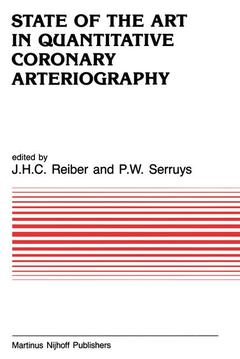State of the Art in Quantitative Coronary Arteriography, 1986 Developments in Cardiovascular Medicine Series, Vol. 53
Langue : Anglais
Coordonnateurs : Reiber Johan H. C., Serruys P.W.

Over the past twenty years, technical advances in coronary arteriography have contributed to our understanding of the pathophysiologic aspects and natural history of coronary artery disease. Probably more than 700. 000 coronary arterio grams are performed annually throughout the world. Usually, these arteriograms are interpreted visually to determine the morphologic extent and severity of coronary artery disease. These subjective determinations, which are hampered . by relatively large intra- and interobserver variations, are used as a basis for critically important therapeutic decisions: Which arteries are to be revascular ized, which lesions are suitable for coronary bypass surgery or for percutaneous coronary angioplasty? To improve on this clinical decision making, on the treat ment and follow-up of such patients, new, objective and reproducible techniques for the assessment of the extent and severity of coronary artery disease, both in terms of anatomy and functional significance of the lesions, must be made widely available. With such new procedures and technologies the efficacy of new thera peutic procedures, the effects of vasodilating and constricting drugs, and the results of long-term studies on the regression and progression of atherosclerotic plaque can be determined in an objective and cost-effective manner.
I: Technical developments in coronary angiography.- 1. Quality considerations on cine-imaging and PTCA-fluoroscopy anticipating a digital future.- 2. Digital coronary arteriography.- 3. Digital imaging modalities for coronary and myocardial wall studies.- 4. Myocardial densograms from digital subtraction angiography with apparent cardiac arrest.- 5. A tomographic approach to intravenous coronary arteriography.- 6. CT of the heart.- II: Quantitative coronary cineangiography.- 7. Quantitation of coronary artery stenosis severity: limitations of angiography and computerized information extraction.- 8. A second look at quantitative coronary angiography: some unexpected problems.- 9. Approaches towards standardization in acquisition and quantitation of arterial dimensions from cineangiograms.- III: Can we measure coronary blood flow from contrast injection?.- 10. Determination of coronary blood flow and myocardial perfusion by digital image processing.- 11. Densitometric assessment of coronary blood velocity and flow in man from coronary angiography: possibilities and problems.- IV: Coronary obstruction and its physiologic significance.- 12. Assessment of stenosis severity.- 13. Effects of coronary artherosclerosis on coronary reserve.- 14. Effects of coronary artery stenosis, aortic insufficiency and aortic stenosis on coronary blood flow in the dog.- 15. Pressure gradient, exercise thallium-201 scintigraphy, quantitative coronary cineangiography: in what sense are these measurements related?.- Index of subjects.
Date de parution : 08-2014
Ouvrage de 274 p.
15.5x23.5 cm
Disponible chez l'éditeur (délai d'approvisionnement : 15 jours).
Prix indicatif 52,74 €
Ajouter au panierThème de State of the Art in Quantitative Coronary Arteriography :
Mots-clés :
Bypass; anatomy; angiography; coronary artery disease; coronary heart disease; drugs; heart
© 2024 LAVOISIER S.A.S.



